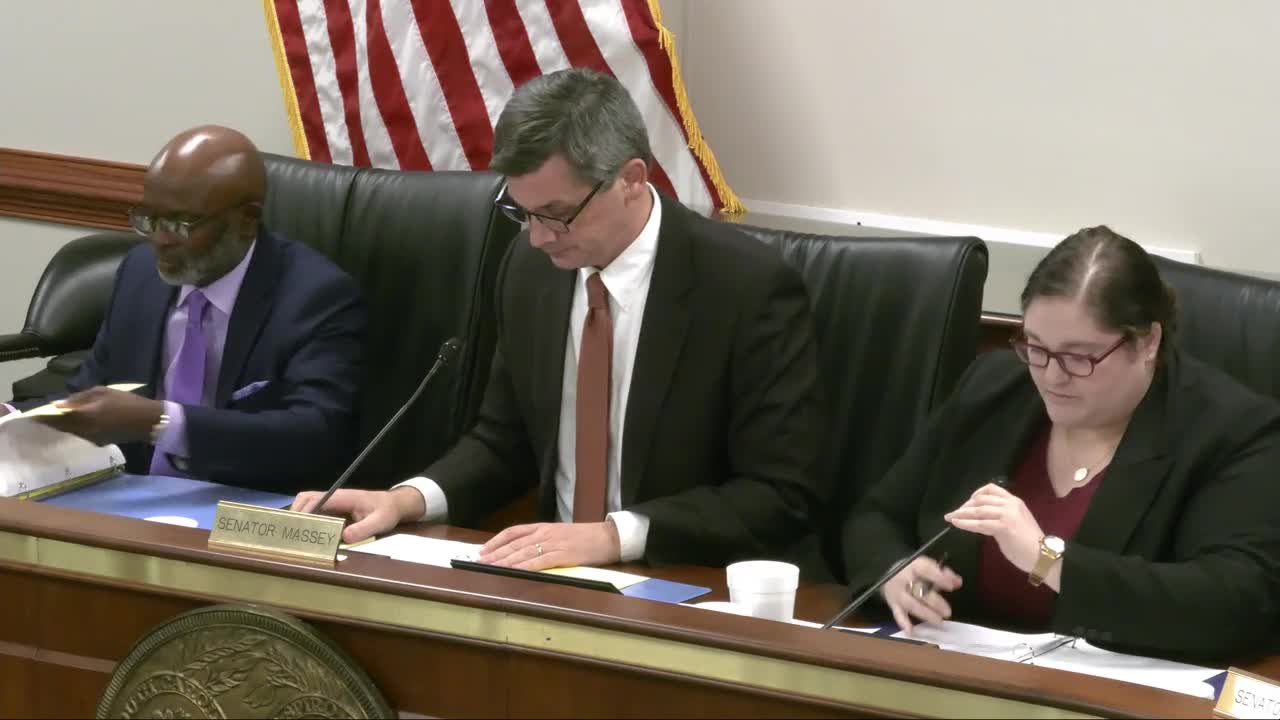Subcommittee debates funeral profession regulation; central question is whether 'physical attendance' can include live online classes
March 12, 2025 | Labor, Commerce and Industry, Standing, Senate, Committees, Legislative, South Carolina
This article was created by AI summarizing key points discussed. AI makes mistakes, so for full details and context, please refer to the video of the full meeting. Please report any errors so we can fix them. Report an error »

A Senate Labor, Commerce and Industry subcommittee reviewed proposed amendments to chapter 57 of the Code of Regulations that implement a 2024 statute affecting funeral service licensure, crematory requirements and continuing education for embalmers and funeral directors.
The regulation package updates definitions related to cremation, clarifies licensure-by-endorsement rules, removes blanket prohibitions on licensure for certain convictions, updates funeral establishment website requirements, and adds crematory requirements that reference alkaline hydrolysis. It also repeals older sections on crematory operator training and preceptor rules. The package was previously carried over because of disagreement over continuing-education language.
Regulation staff told the subcommittee the disputed language stems from the statute’s requirement that licensees complete a minimum number of continuing-education credits and that "2 of the 4 hours" require "physical attendance". Board staff and some industry witnesses said the statute’s phrasing is ambiguous in places, notably whether credits are counted annually or per renewal period and what "physical attendance" means in the era of live, interactive online (synchronous) classes.
Senator Williams and representatives of the South Carolina Funeral Directors Association (SCFDA) argued in favor of keeping an in‑person option. SCFDA President Shannon Dotson and other association representatives said in‑person instruction provides hands‑on training, networking and best practices sharing that matter for a profession that serves grieving families in person. Dotson said the industry has worked toward in‑person training for years and cited recent in‑person programs the industry offered, including a certified crematory operator program held the day before the SCFDA midwinter conference.
Board executive Natalie Mickens and agency staff noted prior practice allowed most continuing education to be completed online and that the board recently interpreted "physical" to include online synchronous instruction (live classes where attendees can interact with the instructor in real time). Speakers highlighted confusion caused by mixed wording in the statute — alternating references to annual and biannual renewal cycles, and to correspondence courses — and several members urged clarifying legislation.
Committee members discussed options: (1) allow the agency to proceed with a regulation that explicitly defines online synchronous learning as satisfying the physical attendance requirement (the House subcommittee had directed withdrawal and resubmission with such language); (2) ask the agency to withdraw the continuing-education portion from regulation and rely on the statute until the legislature cleans the law; or (3) hold the regulation and seek a statutory cleanup. Several senators said the statute as written appears poorly worded and will require legislative clarification regardless of the immediate regulatory path.
The subcommittee agreed to send the regulation to the full committee with an explanatory note and to carry other pending bills; members emphasized the need for a statutory cleanup to remove ambiguity about annual versus renewal‑period counting and the definition of "physical attendance." No final regulatory adoption occurred at the hearing.
The regulation package updates definitions related to cremation, clarifies licensure-by-endorsement rules, removes blanket prohibitions on licensure for certain convictions, updates funeral establishment website requirements, and adds crematory requirements that reference alkaline hydrolysis. It also repeals older sections on crematory operator training and preceptor rules. The package was previously carried over because of disagreement over continuing-education language.
Regulation staff told the subcommittee the disputed language stems from the statute’s requirement that licensees complete a minimum number of continuing-education credits and that "2 of the 4 hours" require "physical attendance". Board staff and some industry witnesses said the statute’s phrasing is ambiguous in places, notably whether credits are counted annually or per renewal period and what "physical attendance" means in the era of live, interactive online (synchronous) classes.
Senator Williams and representatives of the South Carolina Funeral Directors Association (SCFDA) argued in favor of keeping an in‑person option. SCFDA President Shannon Dotson and other association representatives said in‑person instruction provides hands‑on training, networking and best practices sharing that matter for a profession that serves grieving families in person. Dotson said the industry has worked toward in‑person training for years and cited recent in‑person programs the industry offered, including a certified crematory operator program held the day before the SCFDA midwinter conference.
Board executive Natalie Mickens and agency staff noted prior practice allowed most continuing education to be completed online and that the board recently interpreted "physical" to include online synchronous instruction (live classes where attendees can interact with the instructor in real time). Speakers highlighted confusion caused by mixed wording in the statute — alternating references to annual and biannual renewal cycles, and to correspondence courses — and several members urged clarifying legislation.
Committee members discussed options: (1) allow the agency to proceed with a regulation that explicitly defines online synchronous learning as satisfying the physical attendance requirement (the House subcommittee had directed withdrawal and resubmission with such language); (2) ask the agency to withdraw the continuing-education portion from regulation and rely on the statute until the legislature cleans the law; or (3) hold the regulation and seek a statutory cleanup. Several senators said the statute as written appears poorly worded and will require legislative clarification regardless of the immediate regulatory path.
The subcommittee agreed to send the regulation to the full committee with an explanatory note and to carry other pending bills; members emphasized the need for a statutory cleanup to remove ambiguity about annual versus renewal‑period counting and the definition of "physical attendance." No final regulatory adoption occurred at the hearing.
View full meeting
This article is based on a recent meeting—watch the full video and explore the complete transcript for deeper insights into the discussion.
View full meeting